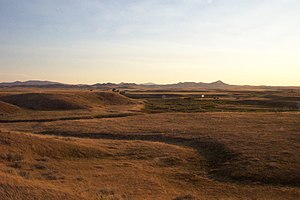Battle of Bearpaw Mountain
| Battle of Bear Paw | |||||||
|---|---|---|---|---|---|---|---|
| Part of the Nez Perce War | |||||||
 Bear Paw Battlefield |
|||||||
|
|||||||
| Belligerents | |||||||
| United States of America | Nez Perce | ||||||
| Commanders and leaders | |||||||
|
Nelson A. Miles Oliver Otis Howard |
Chief Joseph Looking Glass † Ollokot † White Bird Toohoolhoolzote † |
||||||
| Strength | |||||||
| 520 | 700 <200 warriors |
||||||
| Casualties and losses | |||||||
| 24 dead 49 wounded (including 2 Indian scouts) |
23 men and 2 women killed 46 wounded 431 surrendered or captured |
||||||
|
Chief Joseph Battleground of the Bear's Paw
|
|
| Nearest city | Chinook, Montana |
|---|---|
| Coordinates | 48°22′39″N 109°12′26″W / 48.37750°N 109.20722°WCoordinates: 48°22′39″N 109°12′26″W / 48.37750°N 109.20722°W |
| Built | 1877 |
| NRHP reference # | 70000355 |
| Significant dates | |
| Added to NRHP | October 6, 1970 |
| Designated NHL | June 7, 1988 |
The Battle of Bear Paw (also sometimes called Battle of the Bears Paw or Battle of the Bears Paw Mountains) was the final engagement of the Nez Perce War of 1877. Following a 1,200-mile (1,900 km) running fight from western Idaho over the previous four months, the U.S. Army finally managed to corner most of the Nez Perce led by Chief Joseph in early October 1877 in northern Montana Territory, just 42 miles (68 km) south of the border with Canada, where the Nez Perce intended to seek refuge from persecution by the U.S. government.
Although some of the Nez Perce were able to escape to Canada, Chief Joseph was forced to surrender the majority of his followers to General Oliver O. Howard and Colonel Nelson A. Miles on October 5. Today, the battlefield is part of the Nez Perce National Historical Park and the Nez Perce National Historic Trail.
In June 1877, several bands of the Nez Perce, resisting relocation from their traditional lands to a much smaller reservation in west-central Idaho Territory, attempted to escape to the east, following a route through present-day Idaho, Montana and Wyoming over the Rocky Mountains and onto the Great Plains. The Nez Perce began their journey with the mistaken notion that after crossing the next mountain range or defeating the latest army sent to oppose them they would find a peaceful new home. They came to realize, however, that the only sanctuary available to them was in Saskatchewan, Canada alongside the Lakota led by Sitting Bull, who had found asylum there after the Great Sioux War of 1876. After passing through Yellowstone National Park, the Nez Perce headed north through the Montana Territory toward Canada.
...
Wikipedia


